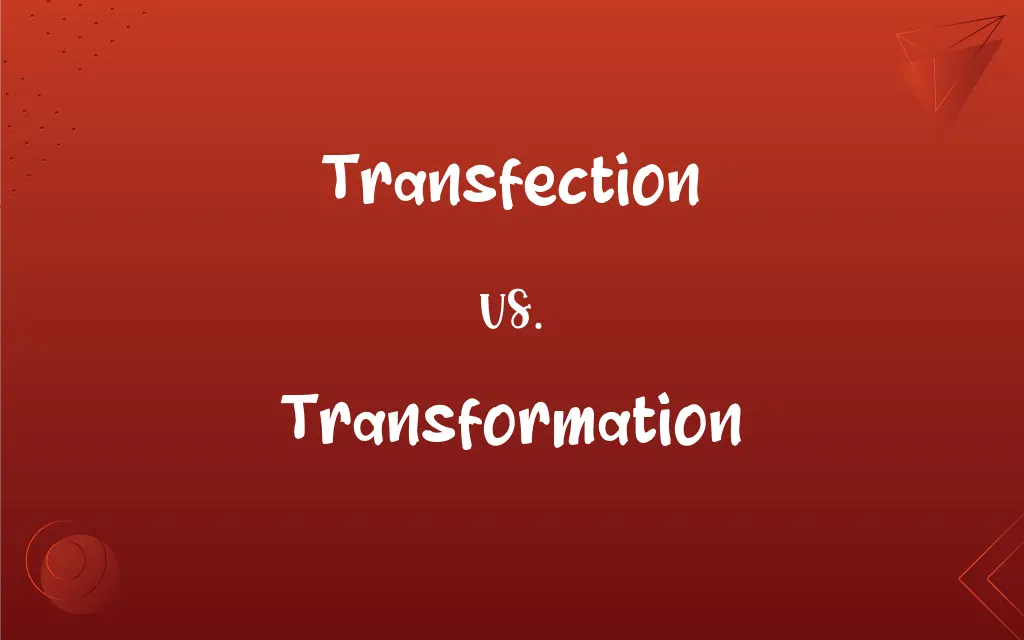Transfection vs. Transformation: What's the Difference?
Edited by Aimie Carlson || By Janet White || Published on November 23, 2023
Transfection involves introducing nucleic acids into cells artificially, while transformation is the genetic alteration of a cell resulting from the uptake of DNA.

Key Differences
Transfection is a laboratory method used to introduce foreign nucleic acids (DNA or RNA) into cells, typically using chemical, lipid, or physical methods. Transformation refers to a process in which a cell takes up foreign DNA from its surroundings and incorporates it into its own genome.
Transfection is primarily used in research to study gene function and regulation, by forcing cells to express new genes. In contrast, transformation can be a natural process in bacteria and is used in genetic engineering to create genetically modified organisms.
Transfection techniques can be transient, where introduced DNA does not integrate into the host genome, or stable, where it does. Transformation, especially in bacteria, often leads to stable genetic changes, as the external DNA becomes part of the bacterial chromosome.
The efficiency and success of transfection depend on the cell type and the method used, with some cells being 'hard to transfect.' Transformation efficiency, especially in bacteria, is enhanced by certain conditions, like the presence of divalent cations, which facilitate DNA uptake.
While transfection is a tool for studying gene function in a controlled environment, transformation is a natural process harnessed for applications like antibiotic resistance studies or creating genetically modified organisms.
ADVERTISEMENT
Comparison Chart
Definition
Introduction of nucleic acids into cells artificially.
Genetic alteration of a cell by uptake of external DNA.
Purpose in Research
Studying gene function and regulation.
Creating genetically modified organisms or studying natural gene uptake.
Types of DNA Introduced
Can be either DNA or RNA.
Primarily DNA.
Stability of Genetic Change
Can be transient or stable.
Often leads to stable genetic changes.
Usage Context
Mainly in controlled laboratory environments.
Both in natural settings (like in bacteria) and in genetic engineering.
ADVERTISEMENT
Transfection and Transformation Definitions
Transfection
Insertion of foreign nucleic acids into eukaryotic cells.
Transfection of cells with GFP allows visualization of cellular processes.
Transformation
The process where a cell incorporates foreign DNA from its environment.
Bacterial transformation is key in recombinant DNA technology.
Transfection
A method to study protein function in cultured cells.
Researchers used transfection to examine protein interactions.
Transformation
Genetic alteration of a cell resulting from DNA uptake.
Transformation of cells can lead to antibiotic resistance.
Transfection
Technique for introducing foreign genetic material into cells.
Transfection of siRNA enabled gene silencing in the experiment.
Transformation
Natural process in bacteria and some other organisms.
The transformation of bacteria is utilized in cloning experiments.
Transfection
Temporary introduction of foreign DNA or RNA into cells.
Transfection was used to temporarily express a protein in lab cells.
Transformation
Introduction of exogenous DNA into a cell, leading to genetic change.
Transformation in yeast cells is a common laboratory procedure.
Transfection
A laboratory technique used for gene expression studies.
Through transfection, the gene's role in cancer was studied.
Transformation
A method used in genetic engineering and biotechnology.
Genetic transformation is fundamental in creating GMOs.
Transfection
Introduction of a segment of DNA or RNA into a eukaryotic cell by means of one of a variety of physical or chemical methods or through viral infection.
Transformation
The act or an instance of transforming
Her difficult transformation of the yard into a garden.
Transfection
(molecular biology) The introduction of foreign genetic material (such as DNA or RNA) into a eukaryotic cell.
Transformation
The state of being transformed
Impressed by the transformation of the yard.
Transformation
A marked change, as in appearance or character, usually for the better
Recent transformations in the format of the publication.
FAQs
Does transformation always integrate DNA into the genome?
In many cases, especially in bacteria, the DNA is integrated into the genome.
Are transfection and transformation used interchangeably?
No, they are distinct processes with different mechanisms and purposes.
What cells are typically used for transfection?
Eukaryotic cells, like mammalian cells, are commonly used for transfection.
What is the role of transformation in antibiotic resistance?
Transformation can spread antibiotic resistance genes among bacterial populations.
Can transformation occur naturally?
Yes, transformation can be a natural process, especially in bacteria.
How is transfection efficiency measured?
Transfection efficiency is often measured by the percentage of cells expressing the introduced gene.
Is transfection used in cancer research?
Yes, transfection is widely used in cancer research to study gene function and regulation.
Are there risks associated with transfection?
Yes, potential risks include cell toxicity and unintended genetic changes.
Does transformation require living cells?
Yes, transformation requires living cells, typically bacteria.
What are the applications of transfection in biotechnology?
Applications include gene therapy, vaccine development, and protein production.
Can transformation introduce RNA into cells?
Typically, transformation involves DNA, not RNA.
What are common methods of transfection?
Lipid-based transfection, electroporation, and chemical methods are common.
Can all bacteria undergo transformation?
No, only certain bacteria, known as competent bacteria, can undergo transformation.
Can transformation be used in gene therapy?
Yes, transformation can be used in gene therapy, especially in bacterial systems.
What factors affect transformation efficiency?
Factors include bacterial strain, DNA concentration, and environmental conditions.
Can transfection be used for protein production?
Yes, transfection is often used for protein production in research labs.
How long does transfection usually last in cells?
Transient transfection lasts a few days, while stable transfection is permanent.
Is transfection possible in all types of cells?
While possible in many cell types, some cells are difficult to transfect.
How do transfection and transformation contribute to genomics research?
They are crucial tools for studying gene function, regulation, and interactions in genomics.
Are there ethical concerns with transfection and transformation?
Yes, ethical concerns arise, especially related to genetic modification and its consequences.
About Author
Written by
Janet WhiteJanet White has been an esteemed writer and blogger for Difference Wiki. Holding a Master's degree in Science and Medical Journalism from the prestigious Boston University, she has consistently demonstrated her expertise and passion for her field. When she's not immersed in her work, Janet relishes her time exercising, delving into a good book, and cherishing moments with friends and family.
Edited by
Aimie CarlsonAimie Carlson, holding a master's degree in English literature, is a fervent English language enthusiast. She lends her writing talents to Difference Wiki, a prominent website that specializes in comparisons, offering readers insightful analyses that both captivate and inform.






































































